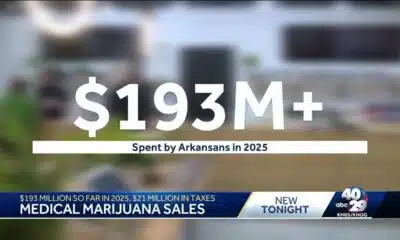News from the South - Arkansas News Feed
Two Arkansas coal-fired plants win exemptions for monitoring toxic air particles
by Ainsley Platt, Arkansas Advocate
April 24, 2025
Two coal-fired power plants in Arkansas are exempt from revised air pollution rules under a Trump administration rollback of environmental standards adopted last year, leaving some former EPA officials and environment groups concerned about prolonged exposure to unhealthy emissions.
The exemptions will last for two years, long enough to keep one plant already slated for closure from having to install equipment required by the new rules.
As part of its deregulation efforts, the Trump administration put out a call earlier this year for companies to request exemptions to several environmental rules finalized in Biden’s last year in office. The Clean Air Act allows the president to exempt pollution sources from compliance with any part of section 112 of the CAA if “the technology to implement the standard is not available and it is in the national security interests of the United States to do so.”
Entergy Arkansas’ White Bluff 1 power station near Redfield and the Plum Point Energy Station near Osceola, which is owned by a consortium of utility companies, applied for the exemption.
GET THE MORNING HEADLINES.
Had President Donald Trump not directed the Environmental Protection Agency to provide the exemptions, the plants would have been required to install continuous emissions monitoring systems (CEMS) to measure the amounts of particulates released into the air. The plants also would have been subject to stricter regulations for how much particulate matter they could release through their stacks.
Instead, the plants will only be subject to the version of the rule prior to the 2024 revisions. The plants now have until 2029 to comply with the requirements finalized last year — that is, if they remain in effect.
The Mercury and Air Toxics (MATS) rule is one of more than two dozen environmental and pollution regulations being targeted for rollbacks by EPA Administrator Lee Zeldin. In a statement announcing the deregulation targets in March, Zeldin said the move was a push back against “destruction and destitution” caused by EPA rules enacted in the previous administration.
The White Bluff plant is scheduled to be shut down in 2028, an Entergy Arkansas spokesperson said.
“White Bluff 1 is the only affected unit in Arkansas that may require the installation of additional equipment to meet new MATS requirements coming into effect in 2027, and that same unit is also subject to a requirement to cease burning coal at the end of 2028 under a consent decree,” Matt Ramsey said in an emailed statement. “This exemption will avoid the need to make additional MATS-related investments that increase costs to our customers so close to the cessation of coal date.
“White Bluff 1 will continue to operate under the current MATS standards, which the EPA has determined to be protective of public health with an adequate margin of safety,” Ramsey added.
MATS matters
The MATS rule was first issued in 2012 to reduce the amount of mercury and other toxics being emitted by coal power plants. Those rules were revised in 2024, during the final months of the Biden administration, requiring all facilities subject to the rule to install CEMS monitoring while tightening the amount of “filterable particulate matter” that a coal power plant could emit.
The revised requirements slashed the amount of particulate matter a coal plant could emit by two-thirds. A fact sheet issued by the EPA last year said that 93% of existing coal plants that were not already set to close already met the revised particulate matter standard.
Particulate matter is used as a surrogate for emissions of mercury, a heavy metal, and other pollutants designated as air toxics under the federal Clean Air Act. Heavy metals can be toxic to humans, and inhaling them can lead to respiratory issues such as asthma.
“Fine particulate matter in the rule and in the science is a proxy for these heavy metals,” explained Sierra Club attorney Tony Mendoza. “So if you’re limiting fine particulate matter to a certain level, EPA found you’re reducing your emissions of mercury and arsenic and nickel.”
Mendoza said he had been surprised that the Plum Point and White Bluff facilities had requested exemptions, saying that documentation put forth by the EPA during the rulemaking process led them to believe it would not be difficult for either plant to comply with the revised rule.
“It seems that they should have been able to comply and there is some non-public reason why they’re seeking that exemption,” Mendoza said. “We were frankly a little surprised to see them on that list.”
Frustration and concern
The chair of the Sierra Club’s Arkansas chapter expressed frustration and concern over the Trump administration’s move. The Sierra Club was one of the plaintiffs in a lawsuit that resulted in the consent decree that requires Entergy to shut down White Bluff and its Independence coal plant within the next ten years.
“Environmental issues tend to work kind of like co-morbidities, where air quality issues on their own might not be causing huge issues for the average Arkansan,” Erica Kriner said, “but then you add poor drinking water from hog farms disposing waste into the Buffalo River; then you add an uptick of diseases that threaten agriculture; and suddenly all of these issues start to snowball with each other.”
Kriner said it was important that Arkansas communities understand the “larger context” of what these actions can mean. She compared the attempts to roll back regulations to a car in need of repair — perhaps it could continue to run at first, but it would eventually stop working.
“Chipping away at our clean air protections may not feel like it will lead to dire consequences, but the Trump administration, the [Sarah] Huckabee Sanders administration, they rely on people not understanding the long-term consequences of dismantling these regulations,” Kriner said.
The exemption from complying with the revised rule was particularly concerning for Joe Goffman, who oversaw the 2024 revisions as the head of the Environmental Protection Agency’s air office during the Biden administration and helped author the section of the Clean Air Act that gave the EPA the authority to regulate so-called “air toxics,” such as mercury, in 1990.
Goffman said the MATS rule exemptions for coal-powered plants would allow these facilities to continue using less frequent testing to demonstrate compliance with the pre-2024 version of the standards, which they are still subject to, if they had not already begun using CEMS.
Goffman said this leaves room for inaccuracies and potentially even manipulation.
“I can say from my many decades of experience in this area — if there was one pollutant” that Congress decided to regulate, “the pollutant to target is PM [particulate matter], because that’s the most dangerous pollutant that makes people sick,” Goffman said.
That’s because harmful substances – like mercury – “ride” on fine particles.
“A lot of these substances are carried by fine particles,” Goffman said. “In other words, you don’t have these free floating nickel molecules or other heavy metal molecules. They ride on fine particles. That’s what makes them particularly lethal.”
Without a CEMS monitoring mandate for all coal plants, Goffman said, there could be “a lot” of particulate matter that is being emitted that isn’t necessarily reflected in reporting.
YOU MAKE OUR WORK POSSIBLE.
Arkansas Advocate is part of States Newsroom, a nonprofit news network supported by grants and a coalition of donors as a 501c(3) public charity. Arkansas Advocate maintains editorial independence. Contact Editor Sonny Albarado for questions: info@arkansasadvocate.com.
The post Two Arkansas coal-fired plants win exemptions for monitoring toxic air particles appeared first on arkansasadvocate.com
Note: The following A.I. based commentary is not part of the original article, reproduced above, but is offered in the hopes that it will promote greater media literacy and critical thinking, by making any potential bias more visible to the reader –Staff Editor.
Political Bias Assessment: Center-Right
The article primarily discusses the Trump administration’s rollback of environmental regulations, particularly with regard to air pollution standards for coal-fired power plants in Arkansas. It presents the viewpoint of the administration’s policy as one focused on deregulation and reducing what is described as “burdensome” restrictions. This reflects a right-leaning stance, as the policy approach aligns with the traditional conservative emphasis on reducing government intervention in business and regulatory practices.
While the article includes criticism from environmental groups and former EPA officials, which represents a left-leaning perspective, the focus on the actions taken under Trump’s deregulation efforts and the framing of those actions as part of a broader conservative agenda signals a Center-Right bias in the overall tone and context. The criticisms of the exemptions are presented as concerns about the long-term impact, but the narrative is largely driven by the deregulation viewpoint associated with the Trump administration.
News from the South - Arkansas News Feed
NW Arkansas Championship expected to bring money to Rogers
SUMMARY: The Northwest Arkansas Championship in Rogers is more than a golf event; it significantly boosts the local economy. Drawing thousands annually, it brings steady crowds benefiting restaurants, shops, and service providers. Businesses report increased sales, especially in food and hydration products, with parking lots near the course filling quickly. The Rogers Chamber estimates the tournament injects around $14 million into the local economy, supporting small businesses. Starting tomorrow with a 5K event at the LPGA, this week-long tournament is a dependable source of customer traffic and highlights Rogers’ growth as a regional hub.
Rogers businesses make money off the LPGA’s NW Arkansas Championship.
40/29 is your home for Northwest Arkansas and the River Valley breaking news and weather. For your latest Northwest Arkansas and the River Valley news and weather visit: https://www.4029tv.com/
For licensing inquiries: https://www.4029tv.com/licensing
News from the South - Arkansas News Feed
Arkansas medical marijuana sales on pace for record year
SUMMARY: Arkansas medical marijuana sales are on track for a record year, with patients spending over $193 million from January to August 2025—more than $10 million higher than last year. The state currently has 109,000 active patient cards, purchasing over 52,000 pounds of cannabis products. Daily sales average around $800,000, generating more than $21 million in taxes this year. A new law directs part of this tax revenue to combat food insecurity, including eliminating school lunch debt statewide. Since 2019, Arkansas patients have spent over $1.5 billion on medical marijuana, with the state collecting more than $105 million in taxes.
Arkansas medical marijuana sales on pace for record year 40/29 is your home for Northwest Arkansas and the River Valley …
News from the South - Arkansas News Feed
Group in lawsuit say Franklin county prison land was bought before it was inspected
SUMMARY: A group filed a complaint against the Franklin County Prison project, claiming the land was purchased before proper inspection, resulting in unsuitable property acquisition and wasted taxpayer money. A study cited by State Senator Brian King revealed the site cannot supply adequate water for even one home, let alone a 3,000-bed prison. Despite ongoing prison overcrowding and the need for a new facility, concerns remain about the project’s viability. Lawmakers discussed the issue, highlighting overcrowding and early release of violent offenders due to lack of space. The Franklin County Prison project aims to build a 3,000-bed facility, but its future is uncertain amid these challenges.
Group in lawsuit say Franklin county prison land was bought before it was inspected
40/29 is your home for Northwest Arkansas and the River Valley breaking news and weather. For your latest Northwest Arkansas and the River Valley news and weather visit: https://www.4029tv.com/
For licensing inquiries: https://www.4029tv.com/licensing
-
News from the South - Kentucky News Feed7 days ago
Lexington man accused of carjacking, firing gun during police chase faces federal firearm charge
-
News from the South - Alabama News Feed7 days ago
Zaxby's Player of the Week: Dylan Jackson, Vigor WR
-
News from the South - Arkansas News Feed7 days ago
Arkansas medical marijuana sales on pace for record year
-
News from the South - North Carolina News Feed5 days ago
What we know about Charlie Kirk shooting suspect, how he was caught
-
Local News7 days ago
US stocks inch to more records as inflation slows and Oracle soars
-
Local News6 days ago
Russian drone incursion in Poland prompts NATO leaders to take stock of bigger threats
-
News from the South - North Carolina News Feed5 days ago
Federal hate crime charge sought in Charlotte stabbing | North Carolina
-
Local News Video6 days ago
Introducing our WXXV Student Athlete of the Week, St. Patrick’s Parker Talley!














































